Digital Imaging Strategy of Kodak
VerifiedAdded on 2023/01/05
|15
|4086
|74
AI Summary
This document discusses the digital imaging strategy of Kodak and the reasons for its strategic failure. It explores the alternative strategies that Kodak could have adopted to deal with the emergence of digital imaging technologies. The document also provides insights and learnings for other companies facing similar challenges.
Contribute Materials
Your contribution can guide someone’s learning journey. Share your
documents today.
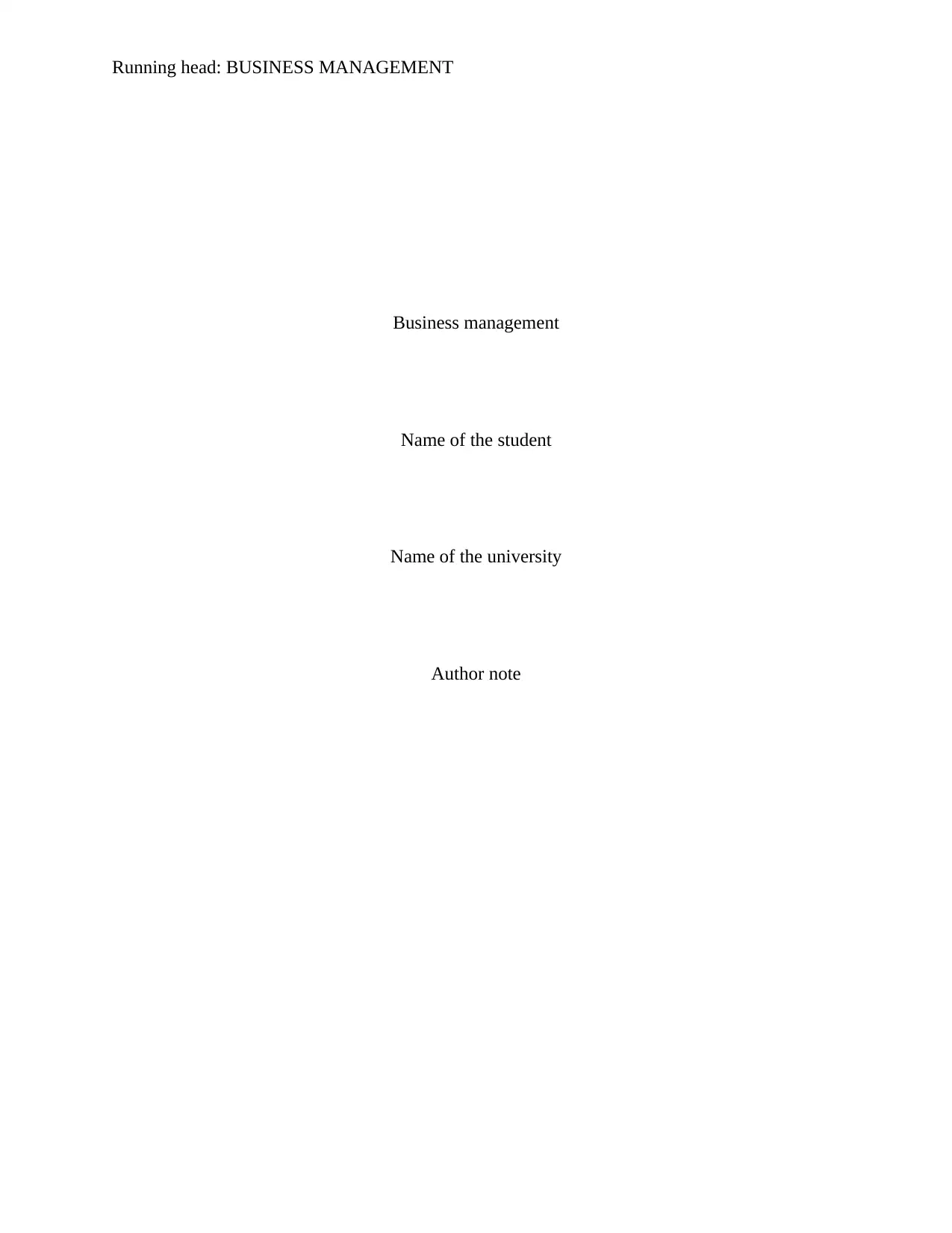
Running head: BUSINESS MANAGEMENT
Business management
Name of the student
Name of the university
Author note
Business management
Name of the student
Name of the university
Author note
Secure Best Marks with AI Grader
Need help grading? Try our AI Grader for instant feedback on your assignments.
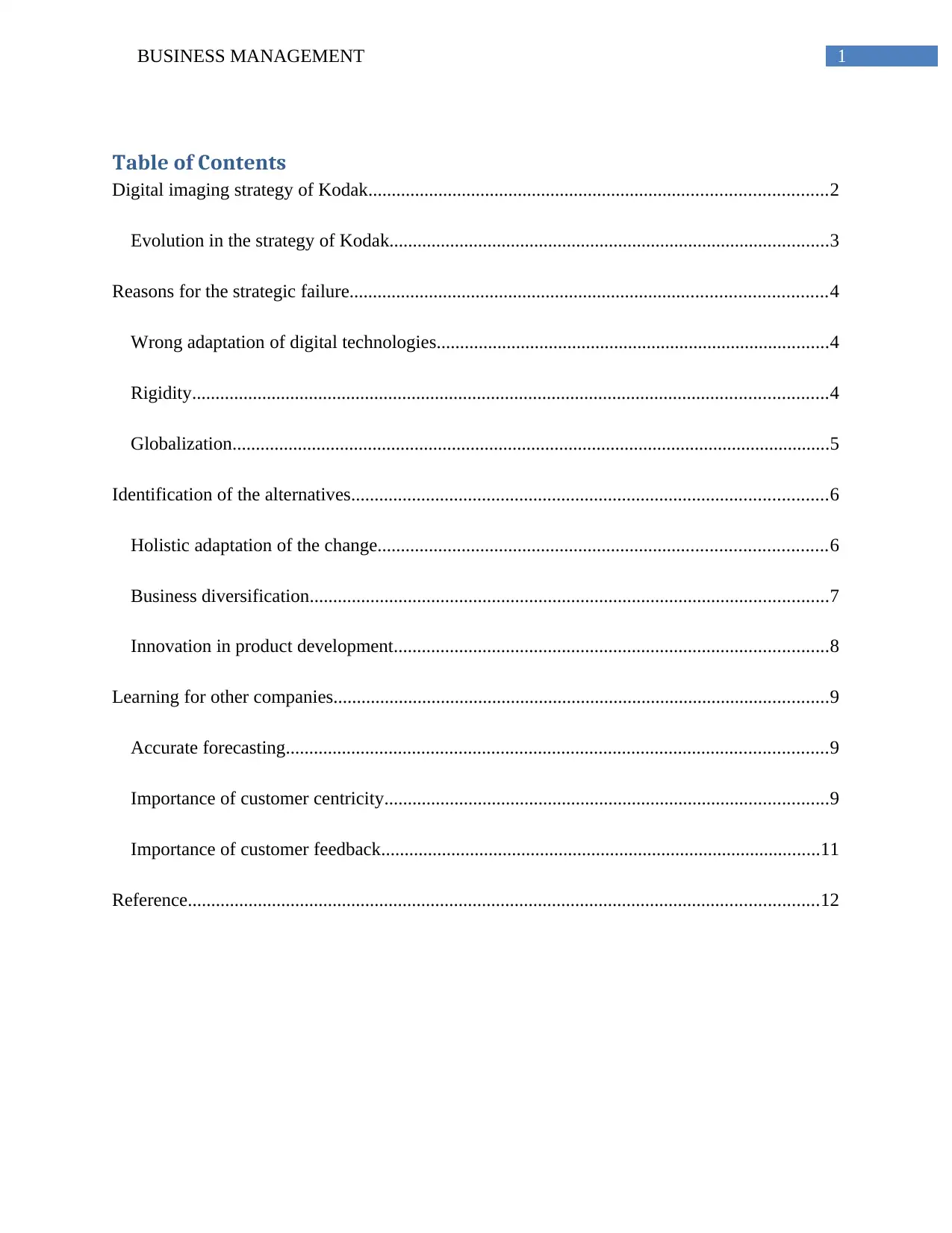
1BUSINESS MANAGEMENT
Table of Contents
Digital imaging strategy of Kodak..................................................................................................2
Evolution in the strategy of Kodak..............................................................................................3
Reasons for the strategic failure......................................................................................................4
Wrong adaptation of digital technologies....................................................................................4
Rigidity........................................................................................................................................4
Globalization................................................................................................................................5
Identification of the alternatives......................................................................................................6
Holistic adaptation of the change................................................................................................6
Business diversification...............................................................................................................7
Innovation in product development.............................................................................................8
Learning for other companies..........................................................................................................9
Accurate forecasting....................................................................................................................9
Importance of customer centricity...............................................................................................9
Importance of customer feedback..............................................................................................11
Reference.......................................................................................................................................12
Table of Contents
Digital imaging strategy of Kodak..................................................................................................2
Evolution in the strategy of Kodak..............................................................................................3
Reasons for the strategic failure......................................................................................................4
Wrong adaptation of digital technologies....................................................................................4
Rigidity........................................................................................................................................4
Globalization................................................................................................................................5
Identification of the alternatives......................................................................................................6
Holistic adaptation of the change................................................................................................6
Business diversification...............................................................................................................7
Innovation in product development.............................................................................................8
Learning for other companies..........................................................................................................9
Accurate forecasting....................................................................................................................9
Importance of customer centricity...............................................................................................9
Importance of customer feedback..............................................................................................11
Reference.......................................................................................................................................12
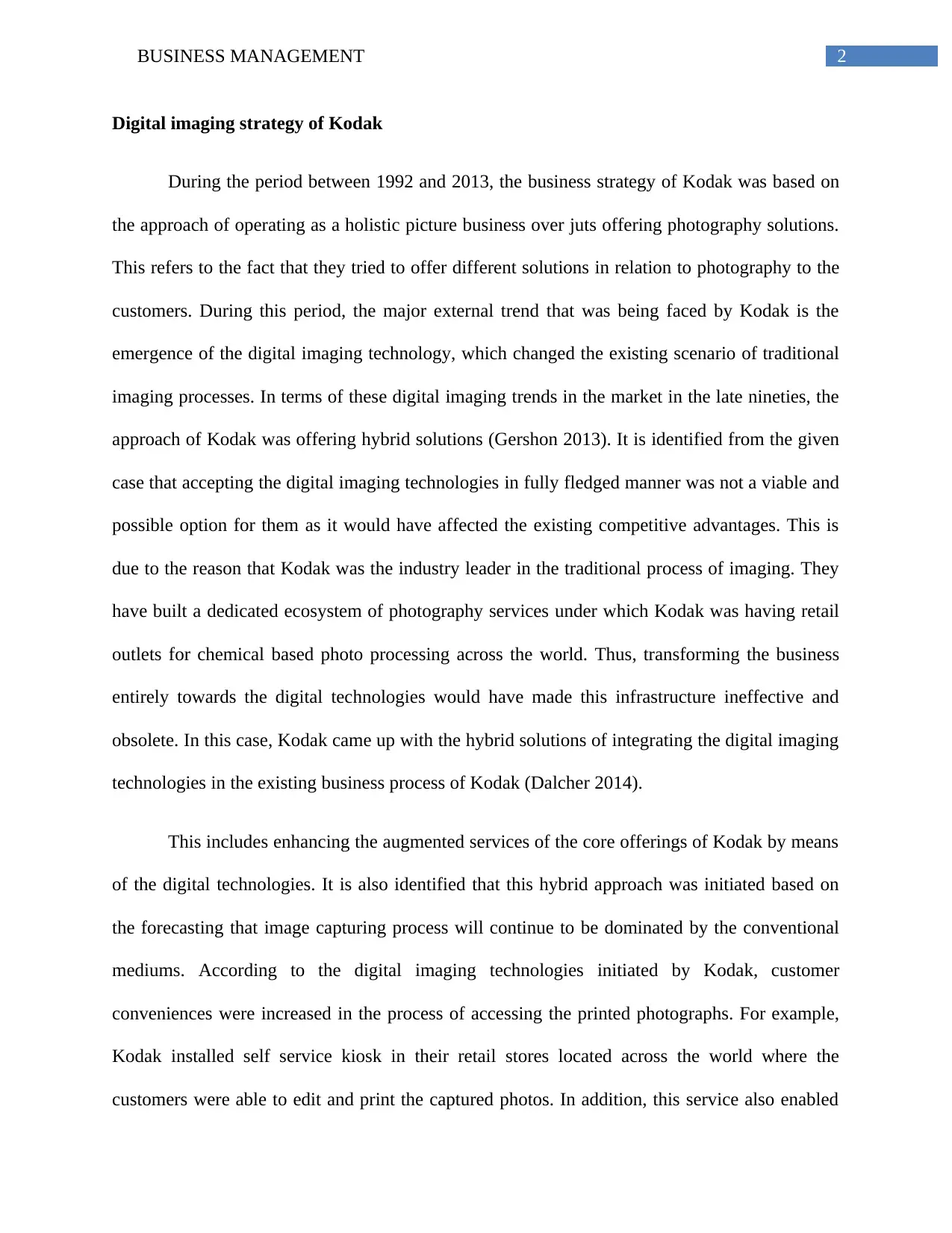
2BUSINESS MANAGEMENT
Digital imaging strategy of Kodak
During the period between 1992 and 2013, the business strategy of Kodak was based on
the approach of operating as a holistic picture business over juts offering photography solutions.
This refers to the fact that they tried to offer different solutions in relation to photography to the
customers. During this period, the major external trend that was being faced by Kodak is the
emergence of the digital imaging technology, which changed the existing scenario of traditional
imaging processes. In terms of these digital imaging trends in the market in the late nineties, the
approach of Kodak was offering hybrid solutions (Gershon 2013). It is identified from the given
case that accepting the digital imaging technologies in fully fledged manner was not a viable and
possible option for them as it would have affected the existing competitive advantages. This is
due to the reason that Kodak was the industry leader in the traditional process of imaging. They
have built a dedicated ecosystem of photography services under which Kodak was having retail
outlets for chemical based photo processing across the world. Thus, transforming the business
entirely towards the digital technologies would have made this infrastructure ineffective and
obsolete. In this case, Kodak came up with the hybrid solutions of integrating the digital imaging
technologies in the existing business process of Kodak (Dalcher 2014).
This includes enhancing the augmented services of the core offerings of Kodak by means
of the digital technologies. It is also identified that this hybrid approach was initiated based on
the forecasting that image capturing process will continue to be dominated by the conventional
mediums. According to the digital imaging technologies initiated by Kodak, customer
conveniences were increased in the process of accessing the printed photographs. For example,
Kodak installed self service kiosk in their retail stores located across the world where the
customers were able to edit and print the captured photos. In addition, this service also enabled
Digital imaging strategy of Kodak
During the period between 1992 and 2013, the business strategy of Kodak was based on
the approach of operating as a holistic picture business over juts offering photography solutions.
This refers to the fact that they tried to offer different solutions in relation to photography to the
customers. During this period, the major external trend that was being faced by Kodak is the
emergence of the digital imaging technology, which changed the existing scenario of traditional
imaging processes. In terms of these digital imaging trends in the market in the late nineties, the
approach of Kodak was offering hybrid solutions (Gershon 2013). It is identified from the given
case that accepting the digital imaging technologies in fully fledged manner was not a viable and
possible option for them as it would have affected the existing competitive advantages. This is
due to the reason that Kodak was the industry leader in the traditional process of imaging. They
have built a dedicated ecosystem of photography services under which Kodak was having retail
outlets for chemical based photo processing across the world. Thus, transforming the business
entirely towards the digital technologies would have made this infrastructure ineffective and
obsolete. In this case, Kodak came up with the hybrid solutions of integrating the digital imaging
technologies in the existing business process of Kodak (Dalcher 2014).
This includes enhancing the augmented services of the core offerings of Kodak by means
of the digital technologies. It is also identified that this hybrid approach was initiated based on
the forecasting that image capturing process will continue to be dominated by the conventional
mediums. According to the digital imaging technologies initiated by Kodak, customer
conveniences were increased in the process of accessing the printed photographs. For example,
Kodak installed self service kiosk in their retail stores located across the world where the
customers were able to edit and print the captured photos. In addition, this service also enabled
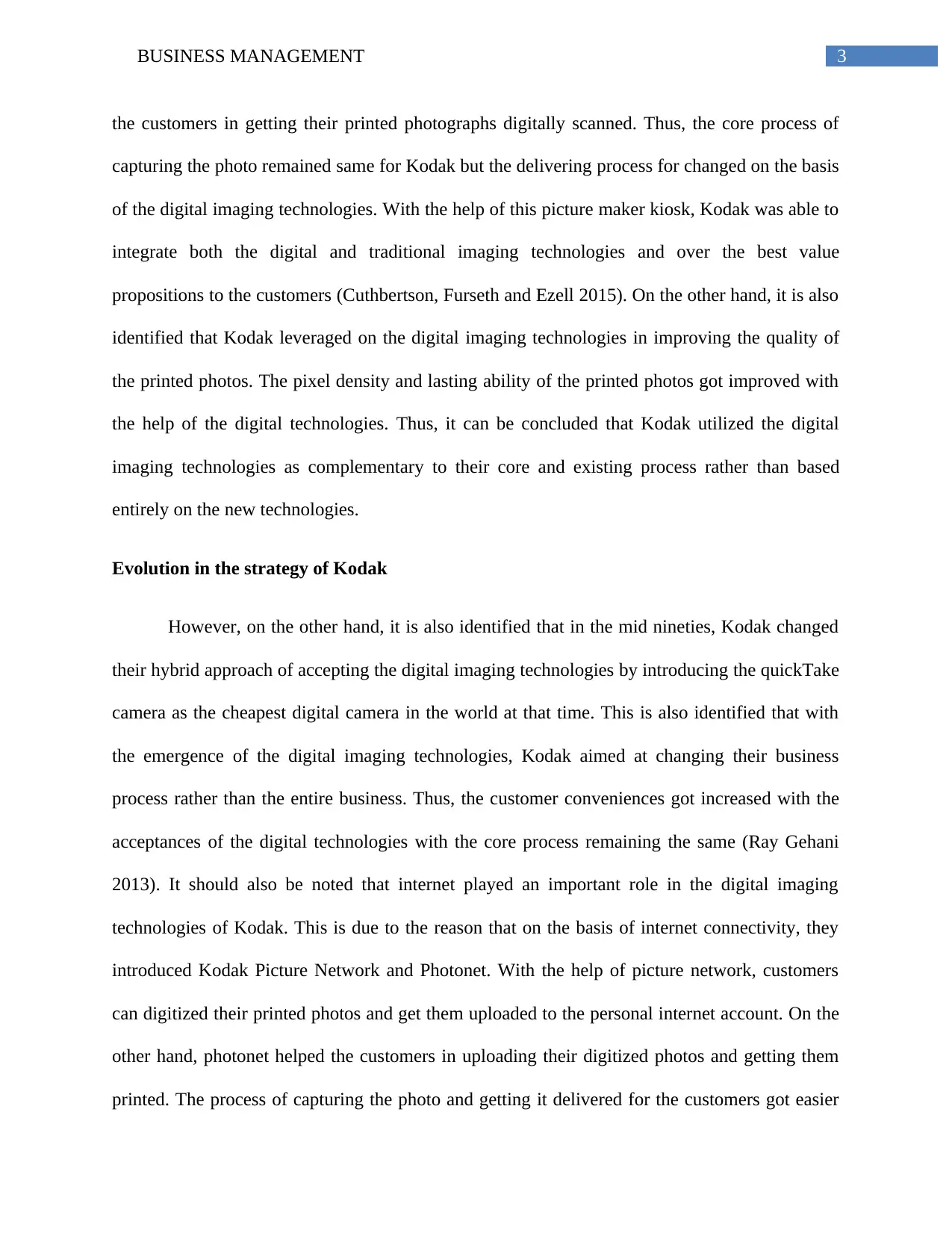
3BUSINESS MANAGEMENT
the customers in getting their printed photographs digitally scanned. Thus, the core process of
capturing the photo remained same for Kodak but the delivering process for changed on the basis
of the digital imaging technologies. With the help of this picture maker kiosk, Kodak was able to
integrate both the digital and traditional imaging technologies and over the best value
propositions to the customers (Cuthbertson, Furseth and Ezell 2015). On the other hand, it is also
identified that Kodak leveraged on the digital imaging technologies in improving the quality of
the printed photos. The pixel density and lasting ability of the printed photos got improved with
the help of the digital technologies. Thus, it can be concluded that Kodak utilized the digital
imaging technologies as complementary to their core and existing process rather than based
entirely on the new technologies.
Evolution in the strategy of Kodak
However, on the other hand, it is also identified that in the mid nineties, Kodak changed
their hybrid approach of accepting the digital imaging technologies by introducing the quickTake
camera as the cheapest digital camera in the world at that time. This is also identified that with
the emergence of the digital imaging technologies, Kodak aimed at changing their business
process rather than the entire business. Thus, the customer conveniences got increased with the
acceptances of the digital technologies with the core process remaining the same (Ray Gehani
2013). It should also be noted that internet played an important role in the digital imaging
technologies of Kodak. This is due to the reason that on the basis of internet connectivity, they
introduced Kodak Picture Network and Photonet. With the help of picture network, customers
can digitized their printed photos and get them uploaded to the personal internet account. On the
other hand, photonet helped the customers in uploading their digitized photos and getting them
printed. The process of capturing the photo and getting it delivered for the customers got easier
the customers in getting their printed photographs digitally scanned. Thus, the core process of
capturing the photo remained same for Kodak but the delivering process for changed on the basis
of the digital imaging technologies. With the help of this picture maker kiosk, Kodak was able to
integrate both the digital and traditional imaging technologies and over the best value
propositions to the customers (Cuthbertson, Furseth and Ezell 2015). On the other hand, it is also
identified that Kodak leveraged on the digital imaging technologies in improving the quality of
the printed photos. The pixel density and lasting ability of the printed photos got improved with
the help of the digital technologies. Thus, it can be concluded that Kodak utilized the digital
imaging technologies as complementary to their core and existing process rather than based
entirely on the new technologies.
Evolution in the strategy of Kodak
However, on the other hand, it is also identified that in the mid nineties, Kodak changed
their hybrid approach of accepting the digital imaging technologies by introducing the quickTake
camera as the cheapest digital camera in the world at that time. This is also identified that with
the emergence of the digital imaging technologies, Kodak aimed at changing their business
process rather than the entire business. Thus, the customer conveniences got increased with the
acceptances of the digital technologies with the core process remaining the same (Ray Gehani
2013). It should also be noted that internet played an important role in the digital imaging
technologies of Kodak. This is due to the reason that on the basis of internet connectivity, they
introduced Kodak Picture Network and Photonet. With the help of picture network, customers
can digitized their printed photos and get them uploaded to the personal internet account. On the
other hand, photonet helped the customers in uploading their digitized photos and getting them
printed. The process of capturing the photo and getting it delivered for the customers got easier
Secure Best Marks with AI Grader
Need help grading? Try our AI Grader for instant feedback on your assignments.
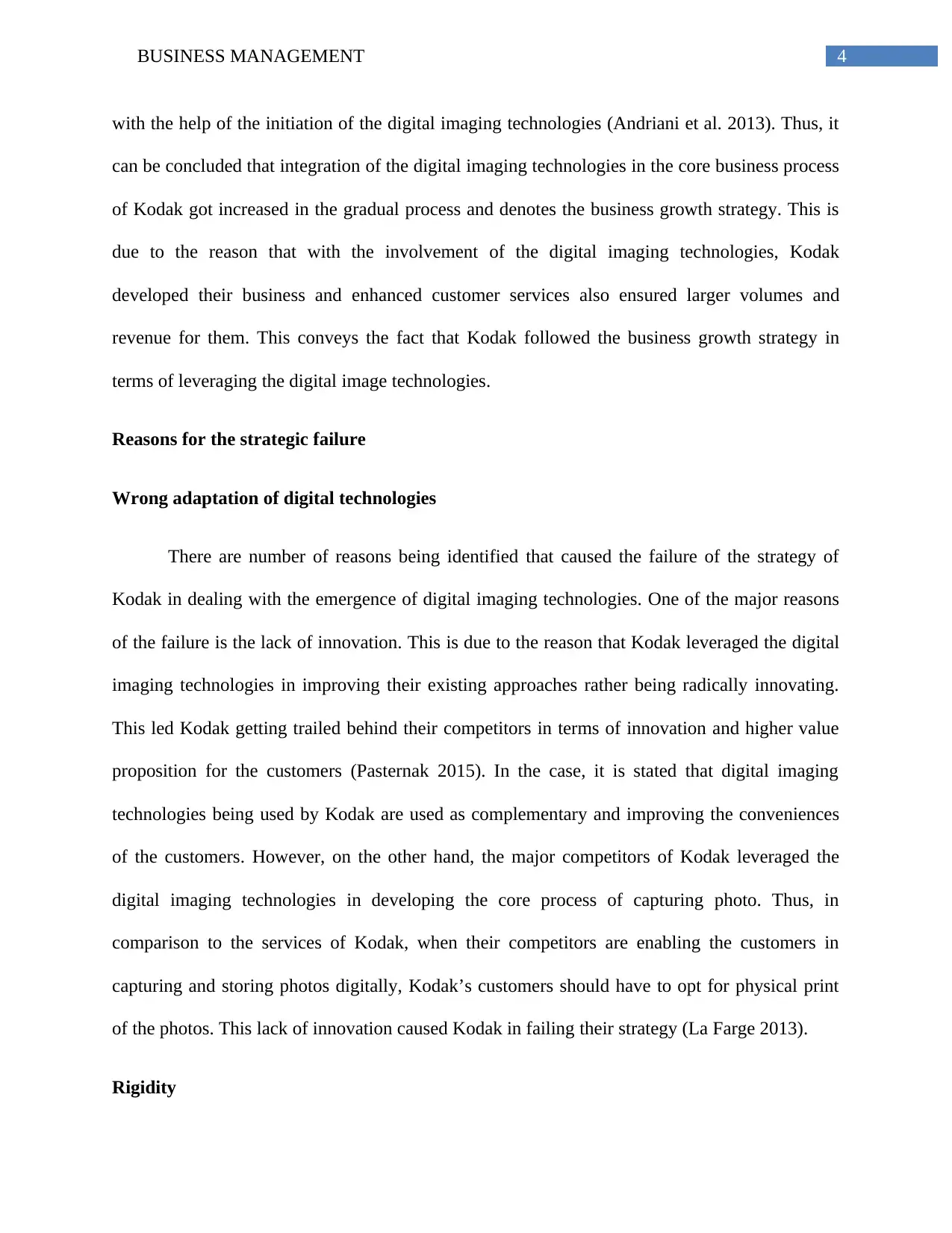
4BUSINESS MANAGEMENT
with the help of the initiation of the digital imaging technologies (Andriani et al. 2013). Thus, it
can be concluded that integration of the digital imaging technologies in the core business process
of Kodak got increased in the gradual process and denotes the business growth strategy. This is
due to the reason that with the involvement of the digital imaging technologies, Kodak
developed their business and enhanced customer services also ensured larger volumes and
revenue for them. This conveys the fact that Kodak followed the business growth strategy in
terms of leveraging the digital image technologies.
Reasons for the strategic failure
Wrong adaptation of digital technologies
There are number of reasons being identified that caused the failure of the strategy of
Kodak in dealing with the emergence of digital imaging technologies. One of the major reasons
of the failure is the lack of innovation. This is due to the reason that Kodak leveraged the digital
imaging technologies in improving their existing approaches rather being radically innovating.
This led Kodak getting trailed behind their competitors in terms of innovation and higher value
proposition for the customers (Pasternak 2015). In the case, it is stated that digital imaging
technologies being used by Kodak are used as complementary and improving the conveniences
of the customers. However, on the other hand, the major competitors of Kodak leveraged the
digital imaging technologies in developing the core process of capturing photo. Thus, in
comparison to the services of Kodak, when their competitors are enabling the customers in
capturing and storing photos digitally, Kodak’s customers should have to opt for physical print
of the photos. This lack of innovation caused Kodak in failing their strategy (La Farge 2013).
Rigidity
with the help of the initiation of the digital imaging technologies (Andriani et al. 2013). Thus, it
can be concluded that integration of the digital imaging technologies in the core business process
of Kodak got increased in the gradual process and denotes the business growth strategy. This is
due to the reason that with the involvement of the digital imaging technologies, Kodak
developed their business and enhanced customer services also ensured larger volumes and
revenue for them. This conveys the fact that Kodak followed the business growth strategy in
terms of leveraging the digital image technologies.
Reasons for the strategic failure
Wrong adaptation of digital technologies
There are number of reasons being identified that caused the failure of the strategy of
Kodak in dealing with the emergence of digital imaging technologies. One of the major reasons
of the failure is the lack of innovation. This is due to the reason that Kodak leveraged the digital
imaging technologies in improving their existing approaches rather being radically innovating.
This led Kodak getting trailed behind their competitors in terms of innovation and higher value
proposition for the customers (Pasternak 2015). In the case, it is stated that digital imaging
technologies being used by Kodak are used as complementary and improving the conveniences
of the customers. However, on the other hand, the major competitors of Kodak leveraged the
digital imaging technologies in developing the core process of capturing photo. Thus, in
comparison to the services of Kodak, when their competitors are enabling the customers in
capturing and storing photos digitally, Kodak’s customers should have to opt for physical print
of the photos. This lack of innovation caused Kodak in failing their strategy (La Farge 2013).
Rigidity
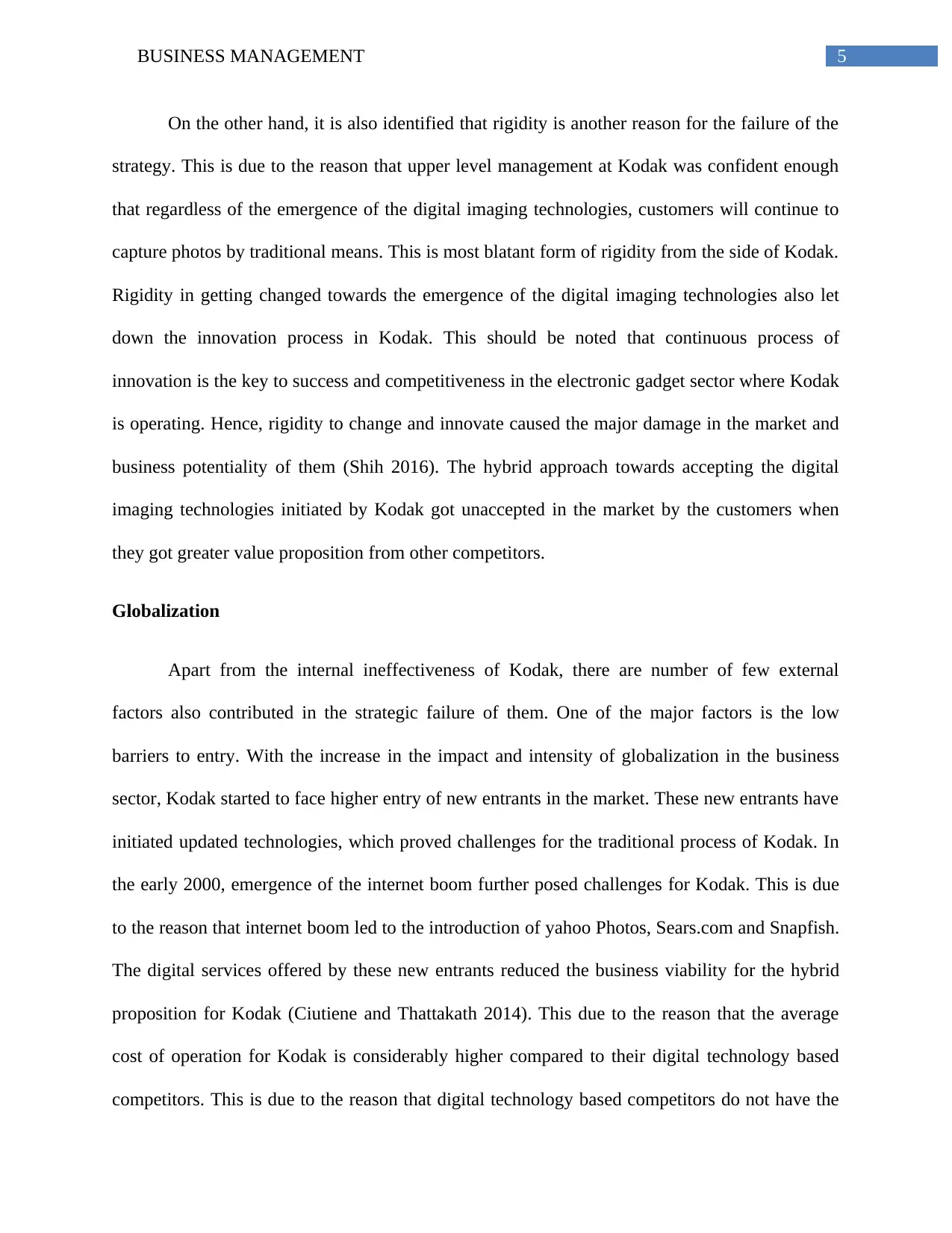
5BUSINESS MANAGEMENT
On the other hand, it is also identified that rigidity is another reason for the failure of the
strategy. This is due to the reason that upper level management at Kodak was confident enough
that regardless of the emergence of the digital imaging technologies, customers will continue to
capture photos by traditional means. This is most blatant form of rigidity from the side of Kodak.
Rigidity in getting changed towards the emergence of the digital imaging technologies also let
down the innovation process in Kodak. This should be noted that continuous process of
innovation is the key to success and competitiveness in the electronic gadget sector where Kodak
is operating. Hence, rigidity to change and innovate caused the major damage in the market and
business potentiality of them (Shih 2016). The hybrid approach towards accepting the digital
imaging technologies initiated by Kodak got unaccepted in the market by the customers when
they got greater value proposition from other competitors.
Globalization
Apart from the internal ineffectiveness of Kodak, there are number of few external
factors also contributed in the strategic failure of them. One of the major factors is the low
barriers to entry. With the increase in the impact and intensity of globalization in the business
sector, Kodak started to face higher entry of new entrants in the market. These new entrants have
initiated updated technologies, which proved challenges for the traditional process of Kodak. In
the early 2000, emergence of the internet boom further posed challenges for Kodak. This is due
to the reason that internet boom led to the introduction of yahoo Photos, Sears.com and Snapfish.
The digital services offered by these new entrants reduced the business viability for the hybrid
proposition for Kodak (Ciutiene and Thattakath 2014). This due to the reason that the average
cost of operation for Kodak is considerably higher compared to their digital technology based
competitors. This is due to the reason that digital technology based competitors do not have the
On the other hand, it is also identified that rigidity is another reason for the failure of the
strategy. This is due to the reason that upper level management at Kodak was confident enough
that regardless of the emergence of the digital imaging technologies, customers will continue to
capture photos by traditional means. This is most blatant form of rigidity from the side of Kodak.
Rigidity in getting changed towards the emergence of the digital imaging technologies also let
down the innovation process in Kodak. This should be noted that continuous process of
innovation is the key to success and competitiveness in the electronic gadget sector where Kodak
is operating. Hence, rigidity to change and innovate caused the major damage in the market and
business potentiality of them (Shih 2016). The hybrid approach towards accepting the digital
imaging technologies initiated by Kodak got unaccepted in the market by the customers when
they got greater value proposition from other competitors.
Globalization
Apart from the internal ineffectiveness of Kodak, there are number of few external
factors also contributed in the strategic failure of them. One of the major factors is the low
barriers to entry. With the increase in the impact and intensity of globalization in the business
sector, Kodak started to face higher entry of new entrants in the market. These new entrants have
initiated updated technologies, which proved challenges for the traditional process of Kodak. In
the early 2000, emergence of the internet boom further posed challenges for Kodak. This is due
to the reason that internet boom led to the introduction of yahoo Photos, Sears.com and Snapfish.
The digital services offered by these new entrants reduced the business viability for the hybrid
proposition for Kodak (Ciutiene and Thattakath 2014). This due to the reason that the average
cost of operation for Kodak is considerably higher compared to their digital technology based
competitors. This is due to the reason that digital technology based competitors do not have the
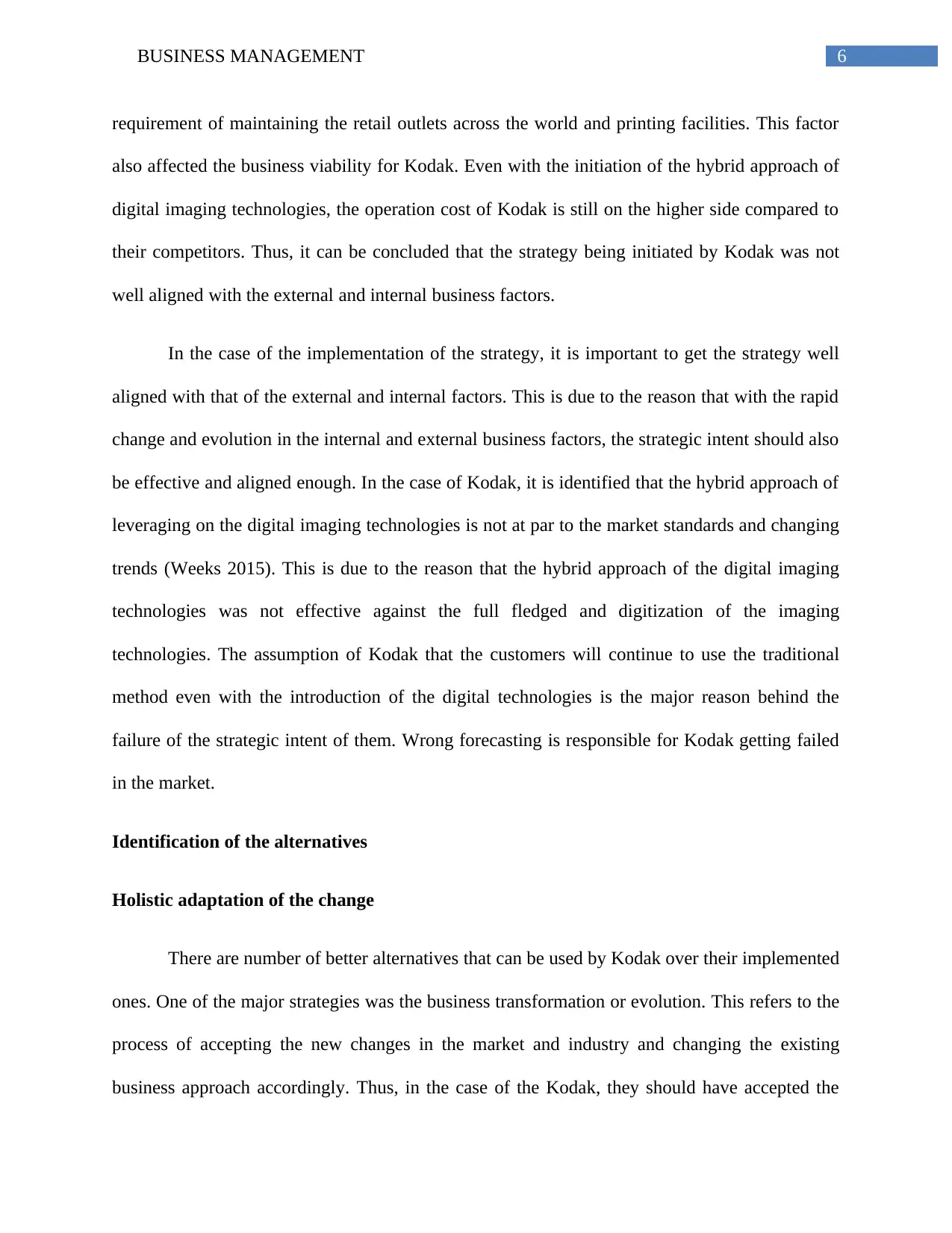
6BUSINESS MANAGEMENT
requirement of maintaining the retail outlets across the world and printing facilities. This factor
also affected the business viability for Kodak. Even with the initiation of the hybrid approach of
digital imaging technologies, the operation cost of Kodak is still on the higher side compared to
their competitors. Thus, it can be concluded that the strategy being initiated by Kodak was not
well aligned with the external and internal business factors.
In the case of the implementation of the strategy, it is important to get the strategy well
aligned with that of the external and internal factors. This is due to the reason that with the rapid
change and evolution in the internal and external business factors, the strategic intent should also
be effective and aligned enough. In the case of Kodak, it is identified that the hybrid approach of
leveraging on the digital imaging technologies is not at par to the market standards and changing
trends (Weeks 2015). This is due to the reason that the hybrid approach of the digital imaging
technologies was not effective against the full fledged and digitization of the imaging
technologies. The assumption of Kodak that the customers will continue to use the traditional
method even with the introduction of the digital technologies is the major reason behind the
failure of the strategic intent of them. Wrong forecasting is responsible for Kodak getting failed
in the market.
Identification of the alternatives
Holistic adaptation of the change
There are number of better alternatives that can be used by Kodak over their implemented
ones. One of the major strategies was the business transformation or evolution. This refers to the
process of accepting the new changes in the market and industry and changing the existing
business approach accordingly. Thus, in the case of the Kodak, they should have accepted the
requirement of maintaining the retail outlets across the world and printing facilities. This factor
also affected the business viability for Kodak. Even with the initiation of the hybrid approach of
digital imaging technologies, the operation cost of Kodak is still on the higher side compared to
their competitors. Thus, it can be concluded that the strategy being initiated by Kodak was not
well aligned with the external and internal business factors.
In the case of the implementation of the strategy, it is important to get the strategy well
aligned with that of the external and internal factors. This is due to the reason that with the rapid
change and evolution in the internal and external business factors, the strategic intent should also
be effective and aligned enough. In the case of Kodak, it is identified that the hybrid approach of
leveraging on the digital imaging technologies is not at par to the market standards and changing
trends (Weeks 2015). This is due to the reason that the hybrid approach of the digital imaging
technologies was not effective against the full fledged and digitization of the imaging
technologies. The assumption of Kodak that the customers will continue to use the traditional
method even with the introduction of the digital technologies is the major reason behind the
failure of the strategic intent of them. Wrong forecasting is responsible for Kodak getting failed
in the market.
Identification of the alternatives
Holistic adaptation of the change
There are number of better alternatives that can be used by Kodak over their implemented
ones. One of the major strategies was the business transformation or evolution. This refers to the
process of accepting the new changes in the market and industry and changing the existing
business approach accordingly. Thus, in the case of the Kodak, they should have accepted the
Paraphrase This Document
Need a fresh take? Get an instant paraphrase of this document with our AI Paraphraser
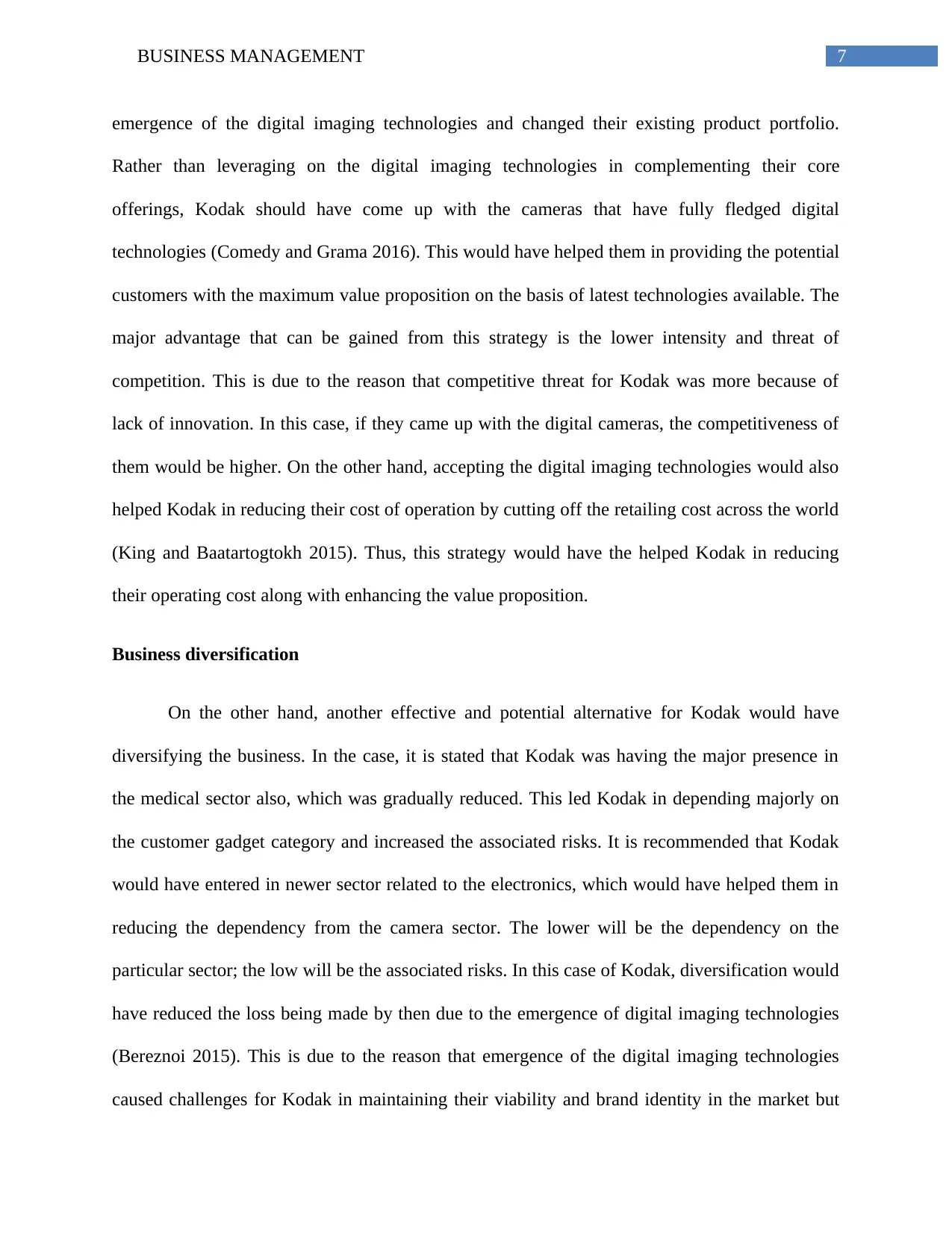
7BUSINESS MANAGEMENT
emergence of the digital imaging technologies and changed their existing product portfolio.
Rather than leveraging on the digital imaging technologies in complementing their core
offerings, Kodak should have come up with the cameras that have fully fledged digital
technologies (Comedy and Grama 2016). This would have helped them in providing the potential
customers with the maximum value proposition on the basis of latest technologies available. The
major advantage that can be gained from this strategy is the lower intensity and threat of
competition. This is due to the reason that competitive threat for Kodak was more because of
lack of innovation. In this case, if they came up with the digital cameras, the competitiveness of
them would be higher. On the other hand, accepting the digital imaging technologies would also
helped Kodak in reducing their cost of operation by cutting off the retailing cost across the world
(King and Baatartogtokh 2015). Thus, this strategy would have the helped Kodak in reducing
their operating cost along with enhancing the value proposition.
Business diversification
On the other hand, another effective and potential alternative for Kodak would have
diversifying the business. In the case, it is stated that Kodak was having the major presence in
the medical sector also, which was gradually reduced. This led Kodak in depending majorly on
the customer gadget category and increased the associated risks. It is recommended that Kodak
would have entered in newer sector related to the electronics, which would have helped them in
reducing the dependency from the camera sector. The lower will be the dependency on the
particular sector; the low will be the associated risks. In this case of Kodak, diversification would
have reduced the loss being made by then due to the emergence of digital imaging technologies
(Bereznoi 2015). This is due to the reason that emergence of the digital imaging technologies
caused challenges for Kodak in maintaining their viability and brand identity in the market but
emergence of the digital imaging technologies and changed their existing product portfolio.
Rather than leveraging on the digital imaging technologies in complementing their core
offerings, Kodak should have come up with the cameras that have fully fledged digital
technologies (Comedy and Grama 2016). This would have helped them in providing the potential
customers with the maximum value proposition on the basis of latest technologies available. The
major advantage that can be gained from this strategy is the lower intensity and threat of
competition. This is due to the reason that competitive threat for Kodak was more because of
lack of innovation. In this case, if they came up with the digital cameras, the competitiveness of
them would be higher. On the other hand, accepting the digital imaging technologies would also
helped Kodak in reducing their cost of operation by cutting off the retailing cost across the world
(King and Baatartogtokh 2015). Thus, this strategy would have the helped Kodak in reducing
their operating cost along with enhancing the value proposition.
Business diversification
On the other hand, another effective and potential alternative for Kodak would have
diversifying the business. In the case, it is stated that Kodak was having the major presence in
the medical sector also, which was gradually reduced. This led Kodak in depending majorly on
the customer gadget category and increased the associated risks. It is recommended that Kodak
would have entered in newer sector related to the electronics, which would have helped them in
reducing the dependency from the camera sector. The lower will be the dependency on the
particular sector; the low will be the associated risks. In this case of Kodak, diversification would
have reduced the loss being made by then due to the emergence of digital imaging technologies
(Bereznoi 2015). This is due to the reason that emergence of the digital imaging technologies
caused challenges for Kodak in maintaining their viability and brand identity in the market but
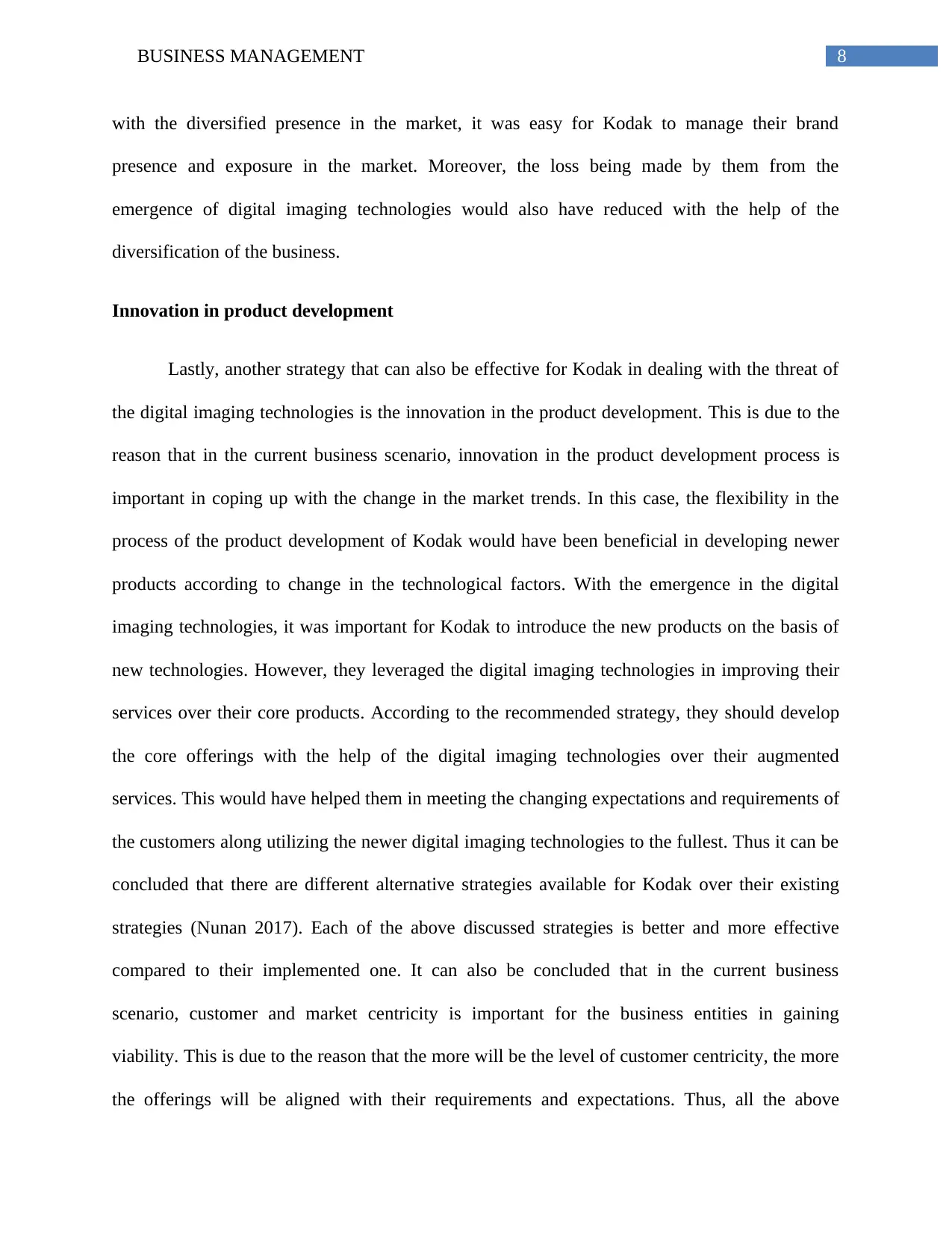
8BUSINESS MANAGEMENT
with the diversified presence in the market, it was easy for Kodak to manage their brand
presence and exposure in the market. Moreover, the loss being made by them from the
emergence of digital imaging technologies would also have reduced with the help of the
diversification of the business.
Innovation in product development
Lastly, another strategy that can also be effective for Kodak in dealing with the threat of
the digital imaging technologies is the innovation in the product development. This is due to the
reason that in the current business scenario, innovation in the product development process is
important in coping up with the change in the market trends. In this case, the flexibility in the
process of the product development of Kodak would have been beneficial in developing newer
products according to change in the technological factors. With the emergence in the digital
imaging technologies, it was important for Kodak to introduce the new products on the basis of
new technologies. However, they leveraged the digital imaging technologies in improving their
services over their core products. According to the recommended strategy, they should develop
the core offerings with the help of the digital imaging technologies over their augmented
services. This would have helped them in meeting the changing expectations and requirements of
the customers along utilizing the newer digital imaging technologies to the fullest. Thus it can be
concluded that there are different alternative strategies available for Kodak over their existing
strategies (Nunan 2017). Each of the above discussed strategies is better and more effective
compared to their implemented one. It can also be concluded that in the current business
scenario, customer and market centricity is important for the business entities in gaining
viability. This is due to the reason that the more will be the level of customer centricity, the more
the offerings will be aligned with their requirements and expectations. Thus, all the above
with the diversified presence in the market, it was easy for Kodak to manage their brand
presence and exposure in the market. Moreover, the loss being made by them from the
emergence of digital imaging technologies would also have reduced with the help of the
diversification of the business.
Innovation in product development
Lastly, another strategy that can also be effective for Kodak in dealing with the threat of
the digital imaging technologies is the innovation in the product development. This is due to the
reason that in the current business scenario, innovation in the product development process is
important in coping up with the change in the market trends. In this case, the flexibility in the
process of the product development of Kodak would have been beneficial in developing newer
products according to change in the technological factors. With the emergence in the digital
imaging technologies, it was important for Kodak to introduce the new products on the basis of
new technologies. However, they leveraged the digital imaging technologies in improving their
services over their core products. According to the recommended strategy, they should develop
the core offerings with the help of the digital imaging technologies over their augmented
services. This would have helped them in meeting the changing expectations and requirements of
the customers along utilizing the newer digital imaging technologies to the fullest. Thus it can be
concluded that there are different alternative strategies available for Kodak over their existing
strategies (Nunan 2017). Each of the above discussed strategies is better and more effective
compared to their implemented one. It can also be concluded that in the current business
scenario, customer and market centricity is important for the business entities in gaining
viability. This is due to the reason that the more will be the level of customer centricity, the more
the offerings will be aligned with their requirements and expectations. Thus, all the above
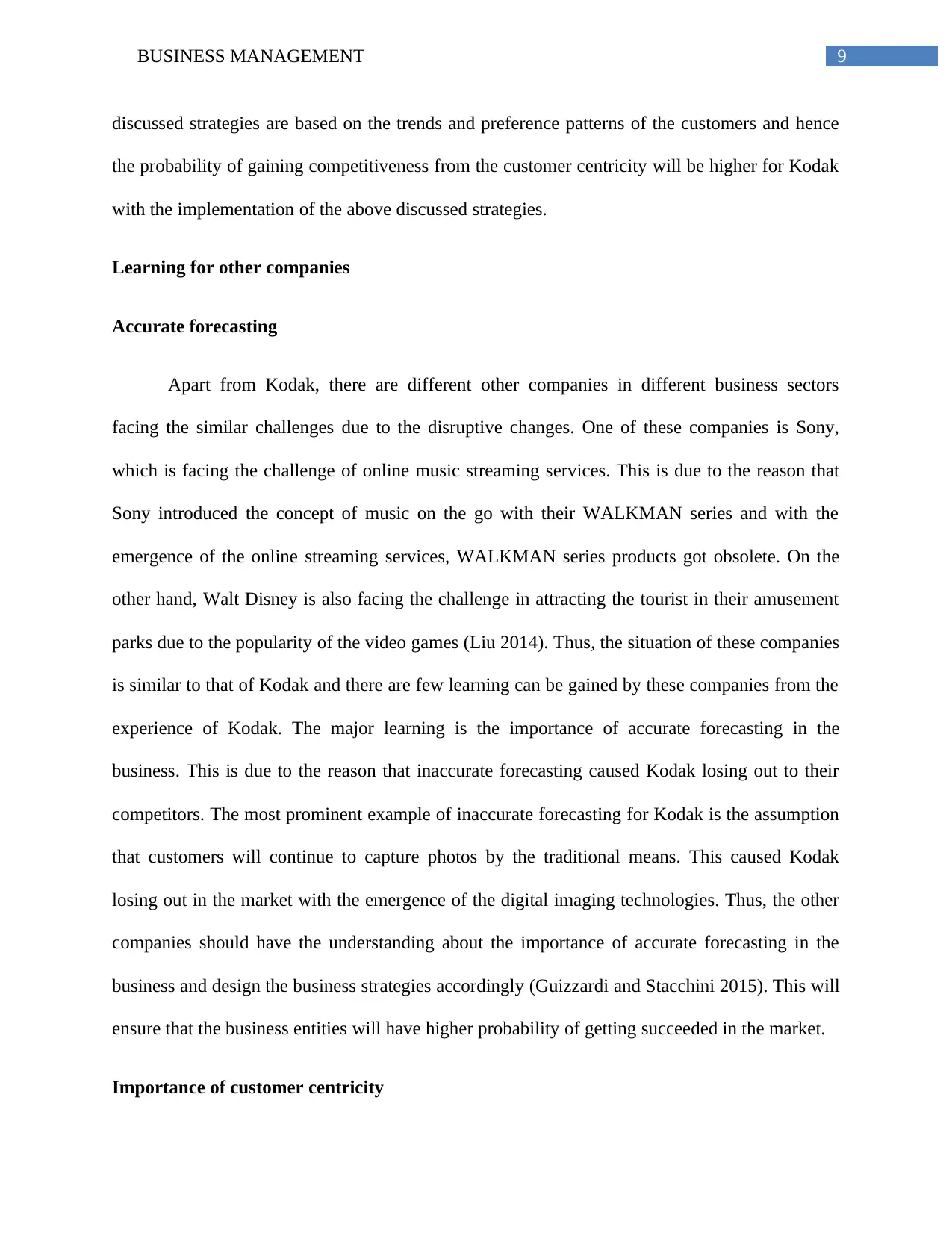
9BUSINESS MANAGEMENT
discussed strategies are based on the trends and preference patterns of the customers and hence
the probability of gaining competitiveness from the customer centricity will be higher for Kodak
with the implementation of the above discussed strategies.
Learning for other companies
Accurate forecasting
Apart from Kodak, there are different other companies in different business sectors
facing the similar challenges due to the disruptive changes. One of these companies is Sony,
which is facing the challenge of online music streaming services. This is due to the reason that
Sony introduced the concept of music on the go with their WALKMAN series and with the
emergence of the online streaming services, WALKMAN series products got obsolete. On the
other hand, Walt Disney is also facing the challenge in attracting the tourist in their amusement
parks due to the popularity of the video games (Liu 2014). Thus, the situation of these companies
is similar to that of Kodak and there are few learning can be gained by these companies from the
experience of Kodak. The major learning is the importance of accurate forecasting in the
business. This is due to the reason that inaccurate forecasting caused Kodak losing out to their
competitors. The most prominent example of inaccurate forecasting for Kodak is the assumption
that customers will continue to capture photos by the traditional means. This caused Kodak
losing out in the market with the emergence of the digital imaging technologies. Thus, the other
companies should have the understanding about the importance of accurate forecasting in the
business and design the business strategies accordingly (Guizzardi and Stacchini 2015). This will
ensure that the business entities will have higher probability of getting succeeded in the market.
Importance of customer centricity
discussed strategies are based on the trends and preference patterns of the customers and hence
the probability of gaining competitiveness from the customer centricity will be higher for Kodak
with the implementation of the above discussed strategies.
Learning for other companies
Accurate forecasting
Apart from Kodak, there are different other companies in different business sectors
facing the similar challenges due to the disruptive changes. One of these companies is Sony,
which is facing the challenge of online music streaming services. This is due to the reason that
Sony introduced the concept of music on the go with their WALKMAN series and with the
emergence of the online streaming services, WALKMAN series products got obsolete. On the
other hand, Walt Disney is also facing the challenge in attracting the tourist in their amusement
parks due to the popularity of the video games (Liu 2014). Thus, the situation of these companies
is similar to that of Kodak and there are few learning can be gained by these companies from the
experience of Kodak. The major learning is the importance of accurate forecasting in the
business. This is due to the reason that inaccurate forecasting caused Kodak losing out to their
competitors. The most prominent example of inaccurate forecasting for Kodak is the assumption
that customers will continue to capture photos by the traditional means. This caused Kodak
losing out in the market with the emergence of the digital imaging technologies. Thus, the other
companies should have the understanding about the importance of accurate forecasting in the
business and design the business strategies accordingly (Guizzardi and Stacchini 2015). This will
ensure that the business entities will have higher probability of getting succeeded in the market.
Importance of customer centricity
Secure Best Marks with AI Grader
Need help grading? Try our AI Grader for instant feedback on your assignments.
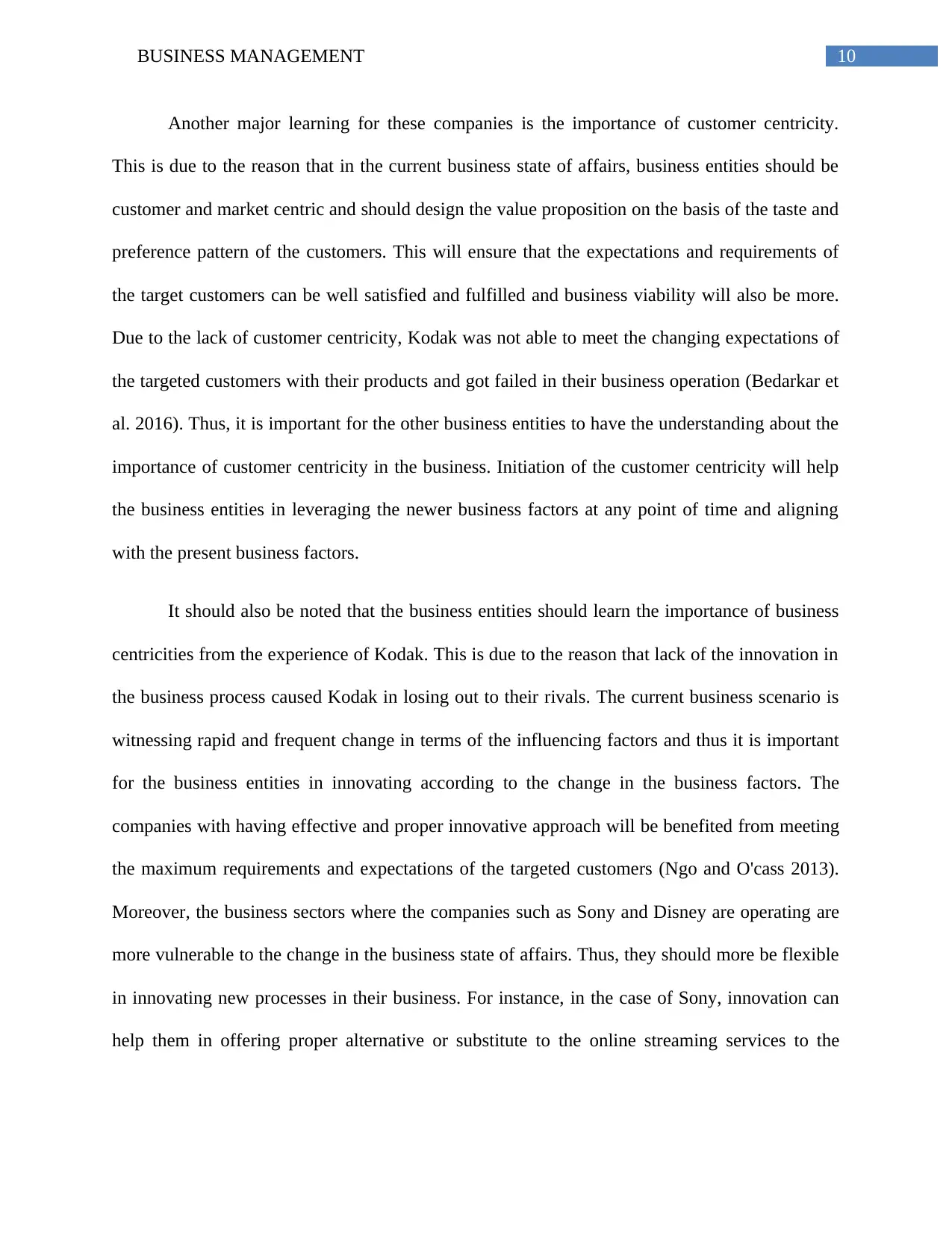
10BUSINESS MANAGEMENT
Another major learning for these companies is the importance of customer centricity.
This is due to the reason that in the current business state of affairs, business entities should be
customer and market centric and should design the value proposition on the basis of the taste and
preference pattern of the customers. This will ensure that the expectations and requirements of
the target customers can be well satisfied and fulfilled and business viability will also be more.
Due to the lack of customer centricity, Kodak was not able to meet the changing expectations of
the targeted customers with their products and got failed in their business operation (Bedarkar et
al. 2016). Thus, it is important for the other business entities to have the understanding about the
importance of customer centricity in the business. Initiation of the customer centricity will help
the business entities in leveraging the newer business factors at any point of time and aligning
with the present business factors.
It should also be noted that the business entities should learn the importance of business
centricities from the experience of Kodak. This is due to the reason that lack of the innovation in
the business process caused Kodak in losing out to their rivals. The current business scenario is
witnessing rapid and frequent change in terms of the influencing factors and thus it is important
for the business entities in innovating according to the change in the business factors. The
companies with having effective and proper innovative approach will be benefited from meeting
the maximum requirements and expectations of the targeted customers (Ngo and O'cass 2013).
Moreover, the business sectors where the companies such as Sony and Disney are operating are
more vulnerable to the change in the business state of affairs. Thus, they should more be flexible
in innovating new processes in their business. For instance, in the case of Sony, innovation can
help them in offering proper alternative or substitute to the online streaming services to the
Another major learning for these companies is the importance of customer centricity.
This is due to the reason that in the current business state of affairs, business entities should be
customer and market centric and should design the value proposition on the basis of the taste and
preference pattern of the customers. This will ensure that the expectations and requirements of
the target customers can be well satisfied and fulfilled and business viability will also be more.
Due to the lack of customer centricity, Kodak was not able to meet the changing expectations of
the targeted customers with their products and got failed in their business operation (Bedarkar et
al. 2016). Thus, it is important for the other business entities to have the understanding about the
importance of customer centricity in the business. Initiation of the customer centricity will help
the business entities in leveraging the newer business factors at any point of time and aligning
with the present business factors.
It should also be noted that the business entities should learn the importance of business
centricities from the experience of Kodak. This is due to the reason that lack of the innovation in
the business process caused Kodak in losing out to their rivals. The current business scenario is
witnessing rapid and frequent change in terms of the influencing factors and thus it is important
for the business entities in innovating according to the change in the business factors. The
companies with having effective and proper innovative approach will be benefited from meeting
the maximum requirements and expectations of the targeted customers (Ngo and O'cass 2013).
Moreover, the business sectors where the companies such as Sony and Disney are operating are
more vulnerable to the change in the business state of affairs. Thus, they should more be flexible
in innovating new processes in their business. For instance, in the case of Sony, innovation can
help them in offering proper alternative or substitute to the online streaming services to the
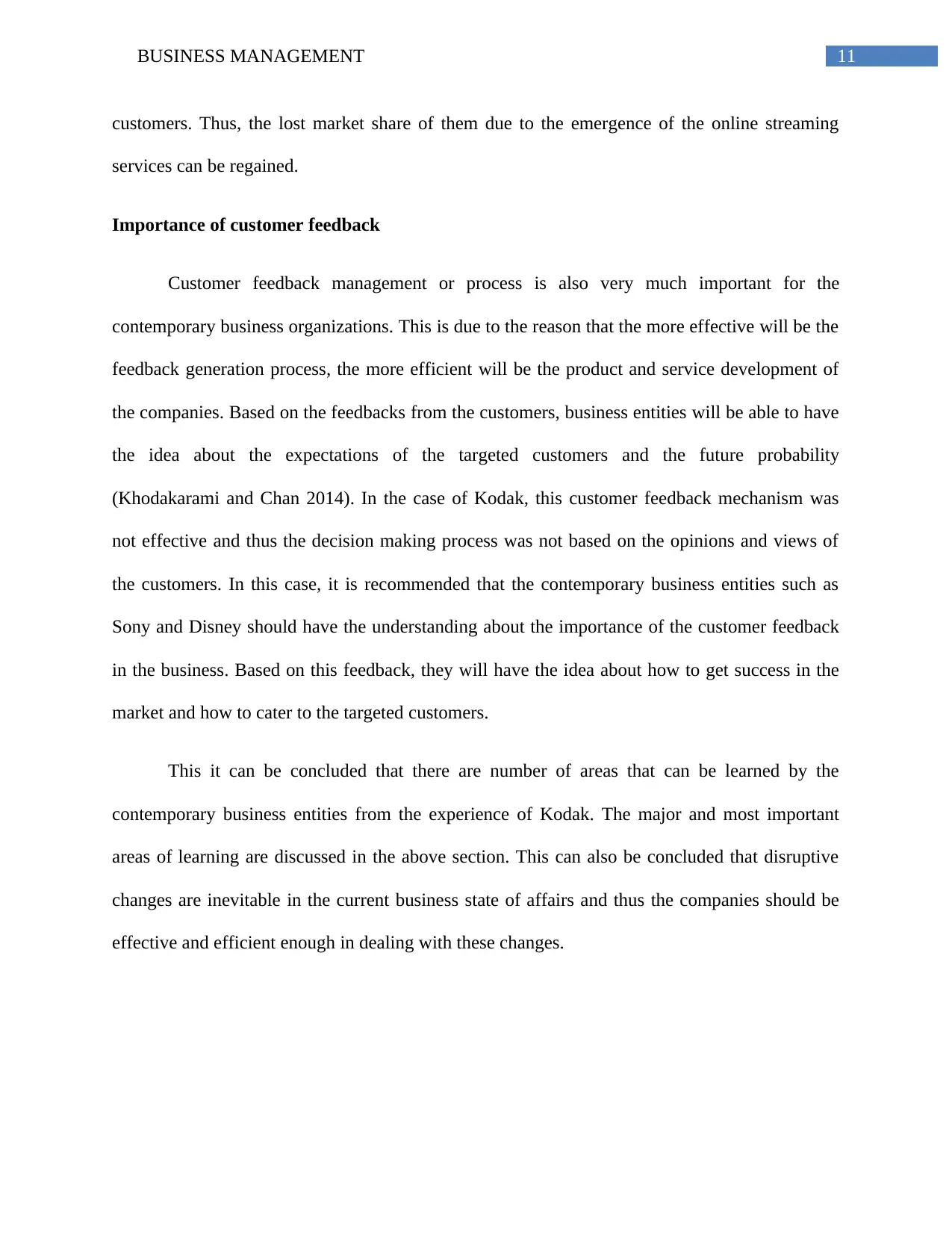
11BUSINESS MANAGEMENT
customers. Thus, the lost market share of them due to the emergence of the online streaming
services can be regained.
Importance of customer feedback
Customer feedback management or process is also very much important for the
contemporary business organizations. This is due to the reason that the more effective will be the
feedback generation process, the more efficient will be the product and service development of
the companies. Based on the feedbacks from the customers, business entities will be able to have
the idea about the expectations of the targeted customers and the future probability
(Khodakarami and Chan 2014). In the case of Kodak, this customer feedback mechanism was
not effective and thus the decision making process was not based on the opinions and views of
the customers. In this case, it is recommended that the contemporary business entities such as
Sony and Disney should have the understanding about the importance of the customer feedback
in the business. Based on this feedback, they will have the idea about how to get success in the
market and how to cater to the targeted customers.
This it can be concluded that there are number of areas that can be learned by the
contemporary business entities from the experience of Kodak. The major and most important
areas of learning are discussed in the above section. This can also be concluded that disruptive
changes are inevitable in the current business state of affairs and thus the companies should be
effective and efficient enough in dealing with these changes.
customers. Thus, the lost market share of them due to the emergence of the online streaming
services can be regained.
Importance of customer feedback
Customer feedback management or process is also very much important for the
contemporary business organizations. This is due to the reason that the more effective will be the
feedback generation process, the more efficient will be the product and service development of
the companies. Based on the feedbacks from the customers, business entities will be able to have
the idea about the expectations of the targeted customers and the future probability
(Khodakarami and Chan 2014). In the case of Kodak, this customer feedback mechanism was
not effective and thus the decision making process was not based on the opinions and views of
the customers. In this case, it is recommended that the contemporary business entities such as
Sony and Disney should have the understanding about the importance of the customer feedback
in the business. Based on this feedback, they will have the idea about how to get success in the
market and how to cater to the targeted customers.
This it can be concluded that there are number of areas that can be learned by the
contemporary business entities from the experience of Kodak. The major and most important
areas of learning are discussed in the above section. This can also be concluded that disruptive
changes are inevitable in the current business state of affairs and thus the companies should be
effective and efficient enough in dealing with these changes.
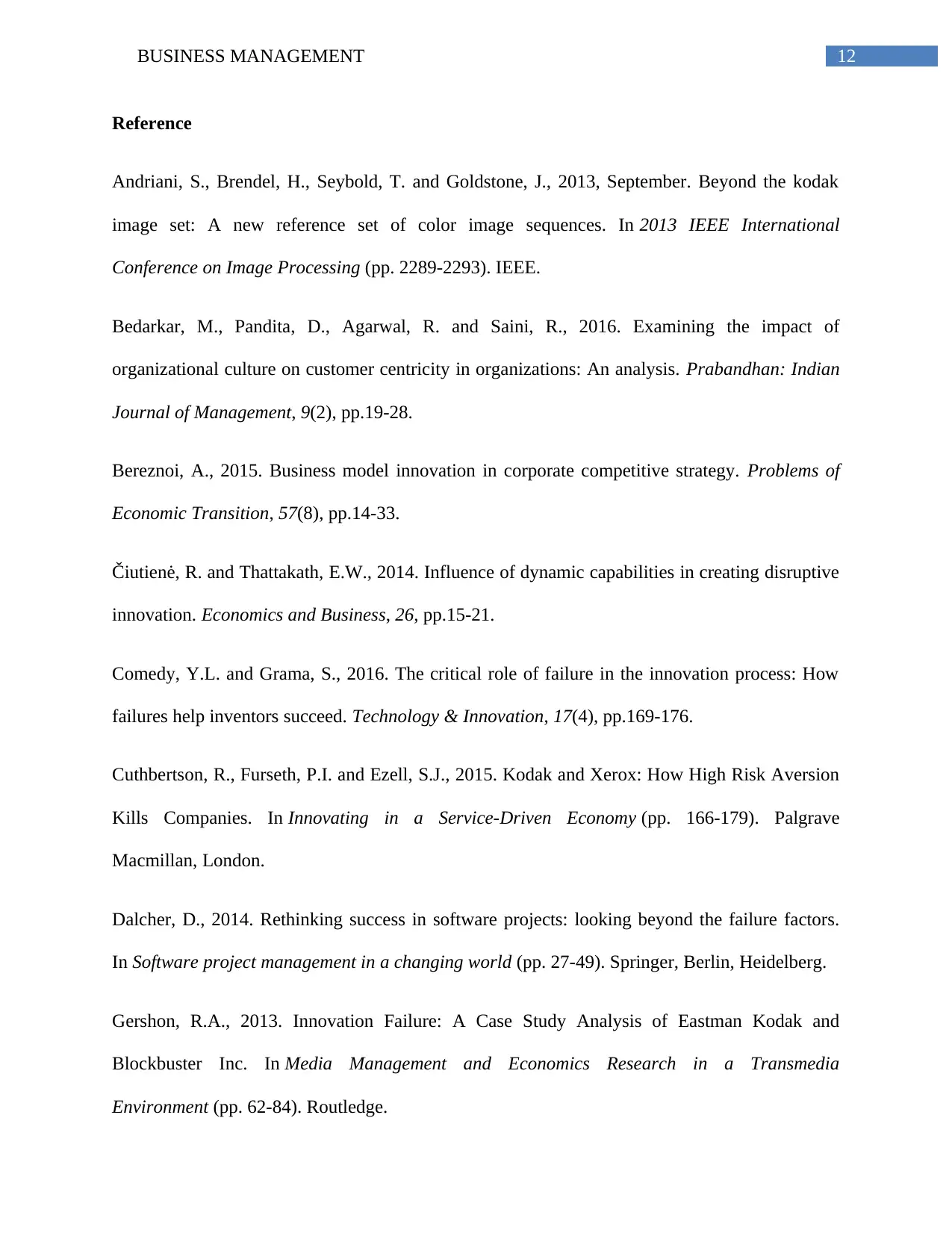
12BUSINESS MANAGEMENT
Reference
Andriani, S., Brendel, H., Seybold, T. and Goldstone, J., 2013, September. Beyond the kodak
image set: A new reference set of color image sequences. In 2013 IEEE International
Conference on Image Processing (pp. 2289-2293). IEEE.
Bedarkar, M., Pandita, D., Agarwal, R. and Saini, R., 2016. Examining the impact of
organizational culture on customer centricity in organizations: An analysis. Prabandhan: Indian
Journal of Management, 9(2), pp.19-28.
Bereznoi, A., 2015. Business model innovation in corporate competitive strategy. Problems of
Economic Transition, 57(8), pp.14-33.
Čiutienė, R. and Thattakath, E.W., 2014. Influence of dynamic capabilities in creating disruptive
innovation. Economics and Business, 26, pp.15-21.
Comedy, Y.L. and Grama, S., 2016. The critical role of failure in the innovation process: How
failures help inventors succeed. Technology & Innovation, 17(4), pp.169-176.
Cuthbertson, R., Furseth, P.I. and Ezell, S.J., 2015. Kodak and Xerox: How High Risk Aversion
Kills Companies. In Innovating in a Service-Driven Economy (pp. 166-179). Palgrave
Macmillan, London.
Dalcher, D., 2014. Rethinking success in software projects: looking beyond the failure factors.
In Software project management in a changing world (pp. 27-49). Springer, Berlin, Heidelberg.
Gershon, R.A., 2013. Innovation Failure: A Case Study Analysis of Eastman Kodak and
Blockbuster Inc. In Media Management and Economics Research in a Transmedia
Environment (pp. 62-84). Routledge.
Reference
Andriani, S., Brendel, H., Seybold, T. and Goldstone, J., 2013, September. Beyond the kodak
image set: A new reference set of color image sequences. In 2013 IEEE International
Conference on Image Processing (pp. 2289-2293). IEEE.
Bedarkar, M., Pandita, D., Agarwal, R. and Saini, R., 2016. Examining the impact of
organizational culture on customer centricity in organizations: An analysis. Prabandhan: Indian
Journal of Management, 9(2), pp.19-28.
Bereznoi, A., 2015. Business model innovation in corporate competitive strategy. Problems of
Economic Transition, 57(8), pp.14-33.
Čiutienė, R. and Thattakath, E.W., 2014. Influence of dynamic capabilities in creating disruptive
innovation. Economics and Business, 26, pp.15-21.
Comedy, Y.L. and Grama, S., 2016. The critical role of failure in the innovation process: How
failures help inventors succeed. Technology & Innovation, 17(4), pp.169-176.
Cuthbertson, R., Furseth, P.I. and Ezell, S.J., 2015. Kodak and Xerox: How High Risk Aversion
Kills Companies. In Innovating in a Service-Driven Economy (pp. 166-179). Palgrave
Macmillan, London.
Dalcher, D., 2014. Rethinking success in software projects: looking beyond the failure factors.
In Software project management in a changing world (pp. 27-49). Springer, Berlin, Heidelberg.
Gershon, R.A., 2013. Innovation Failure: A Case Study Analysis of Eastman Kodak and
Blockbuster Inc. In Media Management and Economics Research in a Transmedia
Environment (pp. 62-84). Routledge.
Paraphrase This Document
Need a fresh take? Get an instant paraphrase of this document with our AI Paraphraser
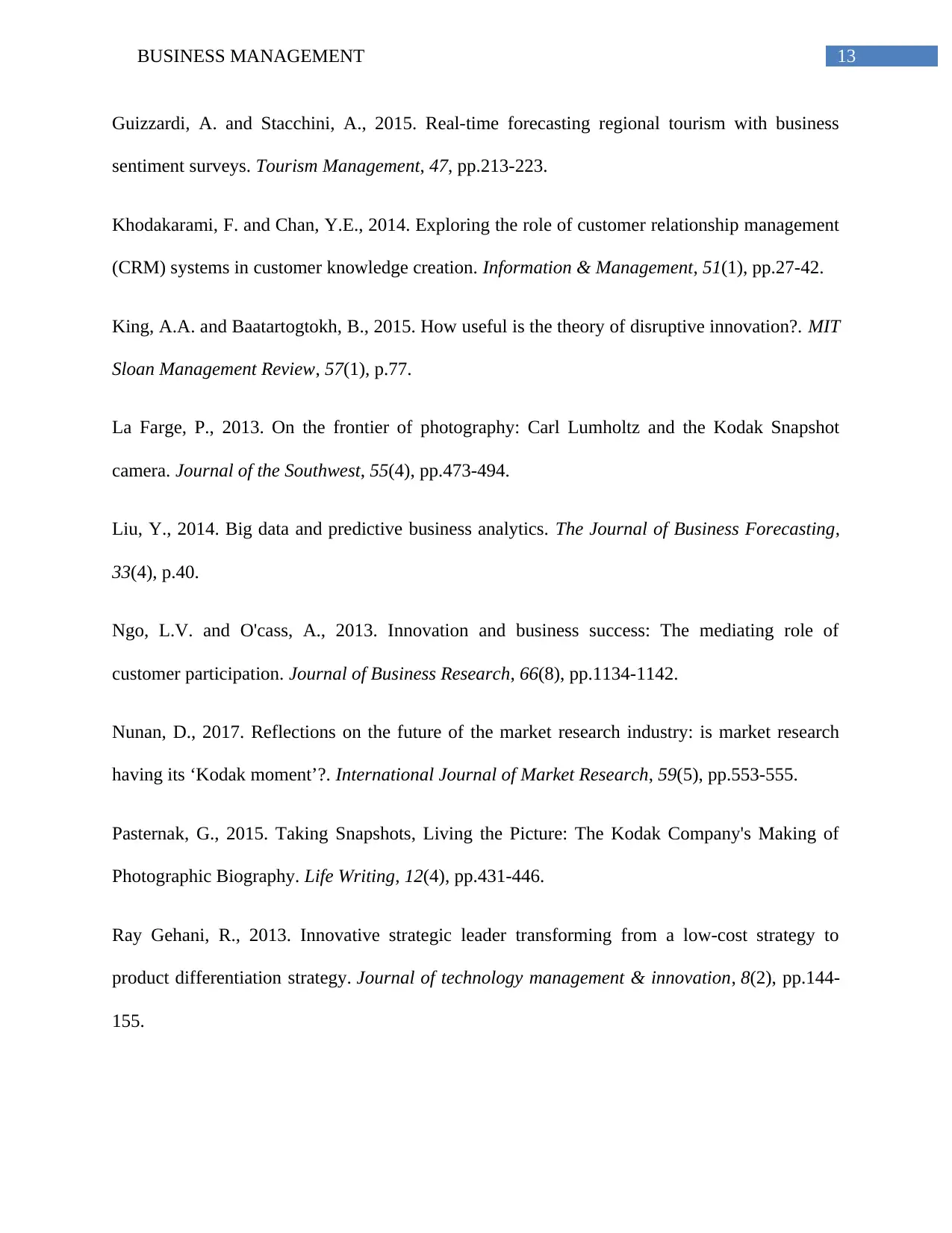
13BUSINESS MANAGEMENT
Guizzardi, A. and Stacchini, A., 2015. Real-time forecasting regional tourism with business
sentiment surveys. Tourism Management, 47, pp.213-223.
Khodakarami, F. and Chan, Y.E., 2014. Exploring the role of customer relationship management
(CRM) systems in customer knowledge creation. Information & Management, 51(1), pp.27-42.
King, A.A. and Baatartogtokh, B., 2015. How useful is the theory of disruptive innovation?. MIT
Sloan Management Review, 57(1), p.77.
La Farge, P., 2013. On the frontier of photography: Carl Lumholtz and the Kodak Snapshot
camera. Journal of the Southwest, 55(4), pp.473-494.
Liu, Y., 2014. Big data and predictive business analytics. The Journal of Business Forecasting,
33(4), p.40.
Ngo, L.V. and O'cass, A., 2013. Innovation and business success: The mediating role of
customer participation. Journal of Business Research, 66(8), pp.1134-1142.
Nunan, D., 2017. Reflections on the future of the market research industry: is market research
having its ‘Kodak moment’?. International Journal of Market Research, 59(5), pp.553-555.
Pasternak, G., 2015. Taking Snapshots, Living the Picture: The Kodak Company's Making of
Photographic Biography. Life Writing, 12(4), pp.431-446.
Ray Gehani, R., 2013. Innovative strategic leader transforming from a low-cost strategy to
product differentiation strategy. Journal of technology management & innovation, 8(2), pp.144-
155.
Guizzardi, A. and Stacchini, A., 2015. Real-time forecasting regional tourism with business
sentiment surveys. Tourism Management, 47, pp.213-223.
Khodakarami, F. and Chan, Y.E., 2014. Exploring the role of customer relationship management
(CRM) systems in customer knowledge creation. Information & Management, 51(1), pp.27-42.
King, A.A. and Baatartogtokh, B., 2015. How useful is the theory of disruptive innovation?. MIT
Sloan Management Review, 57(1), p.77.
La Farge, P., 2013. On the frontier of photography: Carl Lumholtz and the Kodak Snapshot
camera. Journal of the Southwest, 55(4), pp.473-494.
Liu, Y., 2014. Big data and predictive business analytics. The Journal of Business Forecasting,
33(4), p.40.
Ngo, L.V. and O'cass, A., 2013. Innovation and business success: The mediating role of
customer participation. Journal of Business Research, 66(8), pp.1134-1142.
Nunan, D., 2017. Reflections on the future of the market research industry: is market research
having its ‘Kodak moment’?. International Journal of Market Research, 59(5), pp.553-555.
Pasternak, G., 2015. Taking Snapshots, Living the Picture: The Kodak Company's Making of
Photographic Biography. Life Writing, 12(4), pp.431-446.
Ray Gehani, R., 2013. Innovative strategic leader transforming from a low-cost strategy to
product differentiation strategy. Journal of technology management & innovation, 8(2), pp.144-
155.

14BUSINESS MANAGEMENT
Shih, W., 2016. The real lessons from Kodak’s decline. MIT Sloan Management Review, 57(4),
pp.11-13.
Weeks, M.R., 2015. Is disruption theory wearing new clothes or just naked? Analyzing recent
critiques of disruptive innovation theory. Innovation, 17(4), pp.417-428.
Shih, W., 2016. The real lessons from Kodak’s decline. MIT Sloan Management Review, 57(4),
pp.11-13.
Weeks, M.R., 2015. Is disruption theory wearing new clothes or just naked? Analyzing recent
critiques of disruptive innovation theory. Innovation, 17(4), pp.417-428.
1 out of 15
Related Documents
Your All-in-One AI-Powered Toolkit for Academic Success.
+13062052269
info@desklib.com
Available 24*7 on WhatsApp / Email
![[object Object]](/_next/static/media/star-bottom.7253800d.svg)
Unlock your academic potential
© 2024 | Zucol Services PVT LTD | All rights reserved.





